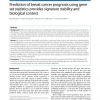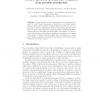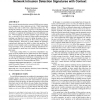207 search results - page 12 / 42 » Expressive Subgroup Signatures |
BMCBI
2010
13 years 8 months ago
2010
Background: Different microarray studies have compiled gene lists for predicting outcomes of a range of treatments and diseases. These have produced gene lists that have little ov...
ECCV
2006
Springer
14 years 9 months ago
2006
Springer
Abstract. Recent studies on three-dimensional face recognition proposed to model facial expressions as isometries of the facial surface. Based on this model, expression-invariant s...
AVBPA
2003
Springer
14 years 1 months ago
2003
Springer
We present a novel 3D face recognition approach based on geometric invariants introduced by Elad and Kimmel. The key idea of the proposed algorithm is a representation of the facia...
PKC
1998
Springer
14 years 3 days ago
1998
Springer
A basic function of all signatures, digital or not, is to express trust and authority, explicit or implied. This is especially the case with digital signatures used in certificates...
CCS
2003
ACM
14 years 1 months ago
2003
ACM
Many network intrusion detection systems (NIDS) use byte sequences as signatures to detect malicious activity. While being highly efficient, they tend to suffer from a high false...



